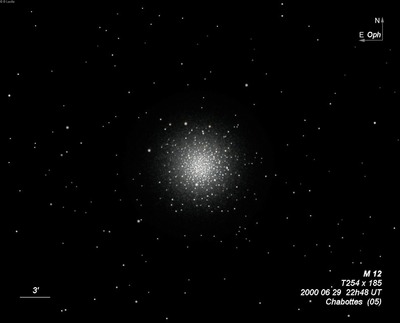
Charles Messier discovered M12 = NGC 6218 = h1971 on 30 May 1764. Johann Bode independently found M12, along with M10, on 14 Aug 1774. William Herschel first observed the globular on 21 May 1783, along with several other clusters, using his 8-inch (10-ft focal length) reflector and noted a "cluster of close stars of different sizes." Using his 18.7-inch (20-ft focal length) on 3 May 1786 (sweep 562), he recorded "a beautiful cluster of very compressed and vS stars; they are however of various magnitudes. The most compressed part takes up about 2'; the whole not less than 7 or 8'. Very gradually most compressed in the middle."
On 15 Apr 1828 (sweep 146), John Herschel called M12 a "v rich globular cluster. The stars 10...16m; vgmbM, but has stragglers in lines and branches extending some distance from the condensed part, which is 3' diam. Comes almost to a blaze in the middle, and has a * 10-11m in the centre." His first observation was on 30 May 1821, while just learning how to sweep.
200/250mm - 8" (6/19/82): the outer halo is well resolved and partial resolution of the core. There are two or three brighter stars in the outer halo.
300/350mm - 13.1" (6/19/82) : bright, large, round, very intense core with faint stars scattered over the core. The outer halo is highly resolved into scores of stars. Slightly inferior to M10 in faint stars.
400/500mm - 17.5" (7/15/99): at 220x this bright cluster is highly resolved over the entire disc. Appears smaller than M10, perhaps 11'-12' diameter with a fairly well-defined 3.5' core. Two bright field stars are embedded in the north edge of the halo and a third bright star is off the following end. A mag 10 star is also superimposed just off the SE edge of the core. A number of brighter resolved mag 12 stars appear to be grouped into pairs and trios. There are a couple of hundred fainter stars in the central 8' over unresolved haze. The outline is very irregular and there are distinctive star-poor areas in the outer halo.
Notes by Steve Gottlieb